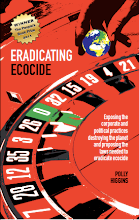
Think back. Like before the Ipod, the Iphone, Google, the Breville toaster, even before black and white television, to the 1880s. Back then two men had a fight over the future of electricity and how it would reach us.
 In one corner was Thomas Edison. He backed DC (electrons flowing in one direction around a circuit). In the other corner was George Westinghouse who backed AC (in which the electrons shuffle back and forth). Edison lost. The reason he lost was because over short distances spanned by early power grids AC suffered lower losses than DC. Subsequently, it became industry standard.
In one corner was Thomas Edison. He backed DC (electrons flowing in one direction around a circuit). In the other corner was George Westinghouse who backed AC (in which the electrons shuffle back and forth). Edison lost. The reason he lost was because over short distances spanned by early power grids AC suffered lower losses than DC. Subsequently, it became industry standard.So what’s the big deal? Well, these days electricity travels much further than it did
in the 1880s. And DC suffers lower losses than AC. So not only does that make DC better in its own right but it would allow electricity grids to be restructured in ways that would make wind power more attractive. That would reduce the need to build more conventional (and polluting) power stations.
You see, wind power has two problems. You don’t always get wind where you want it. And secondly, you don’t always get wind when you want it.
According to Jürgen Schmid, head of ISET, an alternative-energy institute at the University of Kassel, Germany, the answer to both these problems is a continental-wide power distribution. Then the question of where the wind is blowing would no longer matter as the wind is almost always blowing somewhere. If it were windy in Spain but not in West Wales, current would flow in one direction. Conversely if it were a blustery day over here, then it would flow in the other direction.
The ‘when’ aspect of the equation would be to use a country within the European grid to store the electricity until you need it. So how does that work? Well, for example you could use Norway’s hydroelectric plants. The power is used to pump water up into the reservoirs that feed the hydroelectric turbines. That way the power is on tap when you need it.
Should the wind drop all over Europe, which happens rarely, the hydro plants could fill the gap for up to four weeks. Complicated, but at the same time, simple too.
The reason it has not been built goes back to that fight between Edison and Westinghouse back in the 1880’s. He won because high voltage is the best way to transmit power. The higher the voltage, the smaller the loss. Yet AC with its shifting current runs to earth easier, which is another way of saying it loses its power. Hence the reason why the pylons are so high off the ground.
In short, a DC pylon will beat an AC one over long distance (600 miles). And a DC line will beat an AC line at a distance as short as 20 miles. That’s why Dr Schmid calculates that a DC continental grid would allow wind to supply at least 30% of the power needed in Europe. And do so reliably.
Edison was right. DC was the best way to transmit electricity of any given voltage. He was ahead of his time.
Speed read
1 AC may no longer be the future.
2 DC suffers lower losses over longer distance.
3 This will make wind power more commercial.
4 A European-wide power distribution would mean that it won’t matter where the wind is blowing as it is almost always blowing somewhere.
5 Norway has started building DC power lines between Scandinavia, the Netherlands and Germany.
6 Edison may have been right after all.
TREC say the same - use HVDC to transmit clean electricity from concentrating solar power as well as wind throughout Europe, Middle East and North Africa:

Thanks to Howies for telling the story of electricity so well - they make cool clothes too.






